In the world of gourmet food, presentation is just as important as taste. A beautifully plated dish not only appeals to the eyes, but it also enhances the overall dining experience. The art of plating involves arranging various elements on the plate in a harmonious and visually pleasing manner. To create a stunning presentation, it is essential to understand the basic principles of gourmet food plating and ensure that all elements on the plate complement each other.
Harmony in Gourmet Food Plating
Harmony is a key principle in gourmet food plating. It refers to the balance and unity of all elements on the plate, including colors, textures, flavors, and shapes. Achieving harmony can be accomplished by:
- Color: Using contrasting or complementary colors can make a dish visually appealing and create harmony on the plate. For example, pairing vibrant green vegetables with bright red or orange ingredients can create an eye-catching contrast. Additionally, using different shades of the same color can add depth and interest to a dish.
- Texture: Incorporating various textures into a dish can enhance its overall appeal and create harmony on the plate. For example, combining creamy sauces or purees with crispy or crunchy elements can create an interesting contrast that delights the palate.
- Flavor: Balancing flavors is essential for creating harmony on the plate. Combining sweet, salty, sour, bitter, and umami tastes can result in a well-rounded and satisfying dish.
- Shape: Playing with different shapes and forms can add visual interest to a dish and create harmony on the plate. For example, using geometric shapes or organic forms can make a dish more visually appealing.
Principles of Gourmet Food Plating
To achieve harmony on the plate, consider these principles when arranging elements:
- Less is more: Minimalism is often the key to elegant gourmet food plating. Overcrowding the plate with too many ingredients or garnishes can detract from the overall presentation. Focus on a few high-quality ingredients and arrange them in a simple, yet visually appealing manner.
- Create a focal point: A well-plated dish should have a clear focal point or center of interest. This can be achieved by placing the main ingredient or protein in the center of the plate, surrounded by complementary elements such as sauces, garnishes, and accompaniments.
- Use odd numbers: When arranging elements on a plate, consider using odd numbers for a more visually pleasing composition. For example, placing three or five pieces of asparagus instead of four creates a more natural and visually interesting arrangement.
- Consider height and balance: Adding height to a dish can make it more visually appealing and create a sense of balance on the plate. For example, stacking ingredients or using tall garnishes can draw the eye upwards and create visual interest.
- Garnish with purpose: Garnishes should not only be visually appealing but also complement the flavors and textures of the dish. Choose garnishes that add color, texture, or flavor to the dish, rather than simply being decorative.
By understanding harmony and the principles of gourmet food plating, you can create stunning presentations that not only look beautiful but also taste exquisite. Remember to consider color, texture, flavor, and shape when arranging elements on the plate, and use minimalism, focal points, odd numbers, height, and purposeful garnishing to achieve a harmonious and visually pleasing composition.

